Monday was just the beginning of a crazy week (see the previous entry, Come to Me, for that story). Things went decidedly downhill Wednesday, when I was called out before dawn to a wildfire.
I’m decidedly not a firefighter, so why was it a medical call? The person who called it in said there were people fleeing, and unknown injuries. Well before anyone arrived, updates made it pretty clear there were no injuries, but since I was in the area, I may as well continue in to help set up the Command Post.
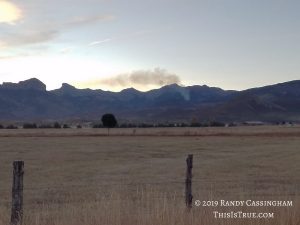
Since there was no hurry, I pulled over on the highway to take a photo as soon as the fire came into view, still from several miles away. Doesn’t look like much, does it?
Just wait. Dry summer and fall — no rain in weeks. Still pretty warm around here, with the National Weather Service frequently issuing “fire watch” and “red flag” advisories, which means some combination of low humidity, warmer than usual temperatures, and/or gusty winds. It grew quickly in what quickly became the catchphrase around here: “tinder-dry forest.”
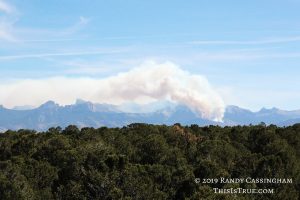
By afternoon it was raging in difficult-to-reach, steep wilderness.
Why Aren’t They Fighting It?
Here in the Social Media Age, rumors and complaints flowed freely. Such as, “Why isn’t the county emergency manager setting up burning restrictions, and getting this fire put out?” Or, “Why don’t they have slurry bombers making quick attacks on this before it grows?” and the related “They’re just letting it burn because it’s good for the forest in the long run, and besides, they don’t care.”
Most of it borders on slander. It’s not the county emergency manager’s job to fight fires, it’s his job to set up contingency plans (read: tons of paperwork to satisfy federal requirements), and then use those plans to provide resources to the people who do respond to the various emergencies. Not to mention he can’t just arbitrarily impose burn restrictions: it’s the sheriff’s job to recommend to the Board of County Commissioners to pass an emergency ordinance. But even if he did do that, it doesn’t apply in federal wilderness lands!
And why not aircraft laying down that orange fire retardant? Because you don’t want that in your water! This one is called the “Owl Creek Fire” because that’s one of many creeks in the area, which flow into the river, which become municipal water supplies. Not to mention that it takes time to get big assets like that ordered up to rural areas.
But can’t they just fly right in? Sure: but then you need people to load up the tanks, and the stuff to put in the tanks, and a place to land the plane so those people can do that job. You can’t do that “immediately,” or even “today” in most cases. In this morning’s briefing, the Incident Commander noted that a “Kmax” helicopter, capable of carrying 2,500 gallons of water, is arriving soon. No retardant doesn’t mean no water!
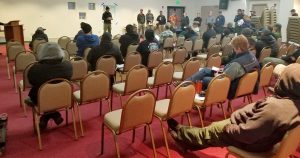
And while it is in fact good for the forest in the long run to burn out the undergrowth, to say the firefighters “don’t care” whether it burns or not is pretty illogical: why would they be here if not to fight fire? If they were going to let it burn, why pay to bring them all in?
What they are doing is difficult to see from miles away: they’re getting well ahead of the fire and setting up fire breaks, using natural terrain features and roads to help set them up quicker.
The Usual Culprit
What’s the culprit in all of this? The usual! Thinking — or the lack thereof. If people did that, they’d realize that there’s not some “vast [you choose: left- or right-] wing conspiracy” to make the fire worse. Rushing people in there means you greatly increase the risk to their safety, so why not do something effective that doesn’t put them in danger? Duh?
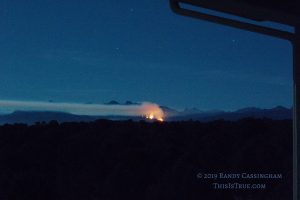
I get it: fires are scary. But thankfully it is in a wilderness area, which means there aren’t houses and businesses burning down.
We’re not suffering like the people of Paradise, Calif., where (allegedly) poorly maintained power lines sparked a fire that burned 153,336 acres (240 square miles, or 62,053 ha), killing 85 people and burning down nearly 19,000 structures.
Really, most people around here are pretty relaxed, though a lot of us were watching like hawks and saw a new “spot fire” start yesterday evening, nearly a mile downwind of the main fire. Yet the firefighters knew it too: a spotter plane patrolling the fire called it in almost immediately. And all was OK: even that was within the boundary where the firefighters are cutting lines, hoping to stop the fire if rain and snow doesn’t do it before it gets to their fire breaks.
“Mismanagement!”
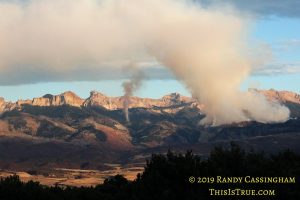
The “favorite” thing I hear about the situation is, “This forest is just as mismanaged as California’s, and we’ve seen the disaster there!” That comes down to thinking too: excluding the territories, there’s about 820 million acres of forest in the U.S. — well over one third of all the land. The same people who point fingers and scream “mismanagement” tend to be the same people who say “we pay too much in taxes!” Yep, “management” takes money, and plenty of it. And when you hold it back, undergrowth happens.
So as usual it comes down to: put up (the money to do the work), or shut up.
Not to mention it’s a lot cheaper: the economic cost of the Paradise fire alone exceeded $16.5 billion. It would have cost less to prevent the fire.
– – –
Bad link? Broken image? Other problem on this page? Use the Help button lower right, and thanks.
This page is an example of my style of “Thought-Provoking Entertainment”. This is True is an email newsletter that uses “weird news” as a vehicle to explore the human condition in an entertaining way. If that sounds good, click here to open a subscribe form.
To really support This is True, you’re invited to sign up for a subscription to the much-expanded “Premium” edition:
Q: Why would I want to pay more than the minimum rate?
A: To support the publication to help it thrive and stay online: this kind of support means less future need for price increases (and smaller increases when they do happen), which enables more people to upgrade. This option was requested by existing Premium subscribers.

Randy, I don’t always agree with you, but I respect your opinions.
What’s your take on the Decker fire? Do you think that was managed well?
We love the people who serve our community through our local fire station (both paid and volunteer), but we’ve been a bit appalled by the recent political upheavals, which got so bad the board fired the Chief (effective immediately) in a closed door session. That was after most of the fire department quit. A few days later, the board hired a lot of people back in a public meeting.
As concerned citizens who attend every public meeting of the board, we’ve seen frank statements by the ex-Chief about how awful it would be if we had a wet summer, and how that would negatively impact the budget. Needless to say, we were taken aback at the idea of firefighters being disappointed by the possibility of fewer fires….
We still support our fire station by attending every fundraiser, and we can’t thank the men and women who serve enough — but we don’t have a lot of faith in the integrity of management at this point (it took quite a few scandals before the board took action).
One would hope that this isn’t typical of CO fire departments, but it’s the only one we’ve seen the inner workings of. I’d love to hear you have had a better experience at your station (I can only assume you’re still a volunteer because they appreciate you and you believe in the department).
So, with all of that in mind, I have to say the Decker fire has been pretty profitable for fire departments, now that it’s large enough to be considered a federally funded emergency. Unfortunately, my conclusions aren’t because I don’t think, but rather because I’ve cared enough to get involved with our local fire department and I’ve learned more than I wanted to know.
But, I would love to hear your thoughts on this fire. Maybe you can somewhat restore my faith in humanity!
—
The Decker Fire is two hours to our east, near Salida, Colo., in the Sangre de Cristo Wilderness — and getting uncomfortably close to town, growing to (currently) 8,700 acres even though it’s been burning for well over a month.
I have no inside info about the fire, but my understanding is that they were at least initially letting it burn, since it was well away from town. They are doing structure protection, and trying to contain spread. From here, I can’t know if that’s the proper strategy or not, but I haven’t heard of any structures being destroyed, so it at least sounds reasonable.
As for your fire chief, if he said that he sounds like a jerk. The firefighters I’ve dealt with (and note, I’m with a “third agency” county-run EMS service that’s separate from police and fire, and I’m not a firefighter myself) are ready to jump when needed, but I’ve never heard any of them “hope” for a fire to help the department’s budget. They don’t want bad stuff to happen, but if it does happen they want to be there to help. -rc
Thanks for adding the Thursday morning picture with the spot fire. It really shows the growth of the original. (And is a stunning photo in its own right.)
People have short memories and even shorter attention spans. They rarely want to see the Big Picture or look ahead. So much easier to find fault and blame others than to think of what’s involved, let alone be part of the solution.
Superb read, but a shame that blame and ignorance spurts up unnecessarily.
This kind of behind-the-scenes look at the responders’ work is really a great part of your site, Randy. We never see enough of how much planning and strategy goes into dealing with such emergencies, and we’re left with immediatist comments like the ones you mentioned.
And of course, also the good ol’ “I want the government to do something about it but I don’t want to pay taxes” bit. I shouldn’t be surprised by that at this point anymore….
The mentality of these complainers reminds me of the Easter Egg Hunt set up by our city. The city park manager obtains donations and volunteers to put on an egg hunt for local children. Prizes such as bicycles, baskets of goodies etc are donated by local businesses. The manager takes the donated cash and buys packaged candies. The packages are distributed on the ground for the children to find and eggs are only for prizes.
The candy is not placed in eggs. The reason is because it would take a lot more money and hours and hours and hours of volunteer time to put the candy in plastic eggs that will most likely be discarded which isn’t great for the environment.
Every year parents complain about the prizes not being good enough, and the candy not being in eggs. There aren’t enough prizes, there aren’t enough referees making sure everything is fair, etc.
When I volunteered and heard a complaint I always exclaimed “oh that is awesome, we always have trouble finding volunteers, I’m pleased that you are willing to donate your time to stuff these eggs. What’s your name and number? I’ll call you next year, please plan for five eight-hour days, that’s how long it takes, and thanks so much for stepping up”. I never got a phone number. They didn’t want to help, just gripe about it.
—
Perfect response. -rc
The idea that firefighters would like MORE fires to fight, for whatever reason, is laughably ludicrous! No intelligent firefighter would ever say that, whether paid or volunteer. They do what they do because they feel a calling to help & protect others. They would LOVE to have no fires to fight. Heck, they’d CELEBRATE!!! They would much rather do something that DOESN’T risk their lives every time they respond. How do I know this? I was blessed & incredibly proud to grow up as the grandson of a volunteer firefighter.
We are having a lot of wildfires here in Australia at present and I blame local councils and state governments for much of the problems. Many councils refuse to cut roadside grass for political (green) or financial reasons and when a fire starts it travels at high speed along the verges in the metre (40 inch) plus high grass.
The state government for the same reasons refuse to do burns to reduce the fuel load in state forests so when those light up roads are closed and people are trapped in small towns.
Worse still the Queensland government is rolling out a series of new fire trucks that stop dead when a defect of some sort occurs.
I can see a crew being cremated before they will acknowledge that the trucks must have an emergency override to allow them to escape a fire trap.
Equally bad the centre of gravity is too far back and too high so this makes the trucks unstable on steep slopes
As someone who experienced the Raton Pass (Colorado) fire a few years back, I am *still* amazed at what the firefighters do when large areas are burning out of control. The emergency folks (fire, EMT, etc.) have always had and always will have my deepest respect! Thank you, Randy, for your service!
—
Yeah, I’m really glad there are people who love that sort of thing, since I’d hate it! (And yeah, I know, most of them wouldn’t want my job either!) Luckily, there are all sorts of different people in the world, and that’s definitely something to celebrate. -rc